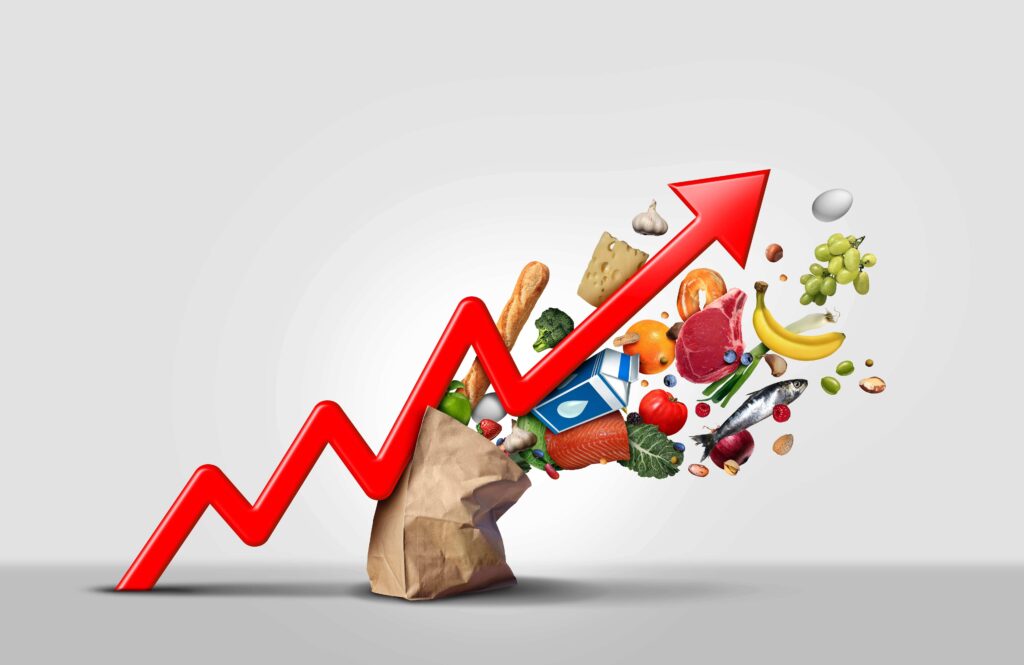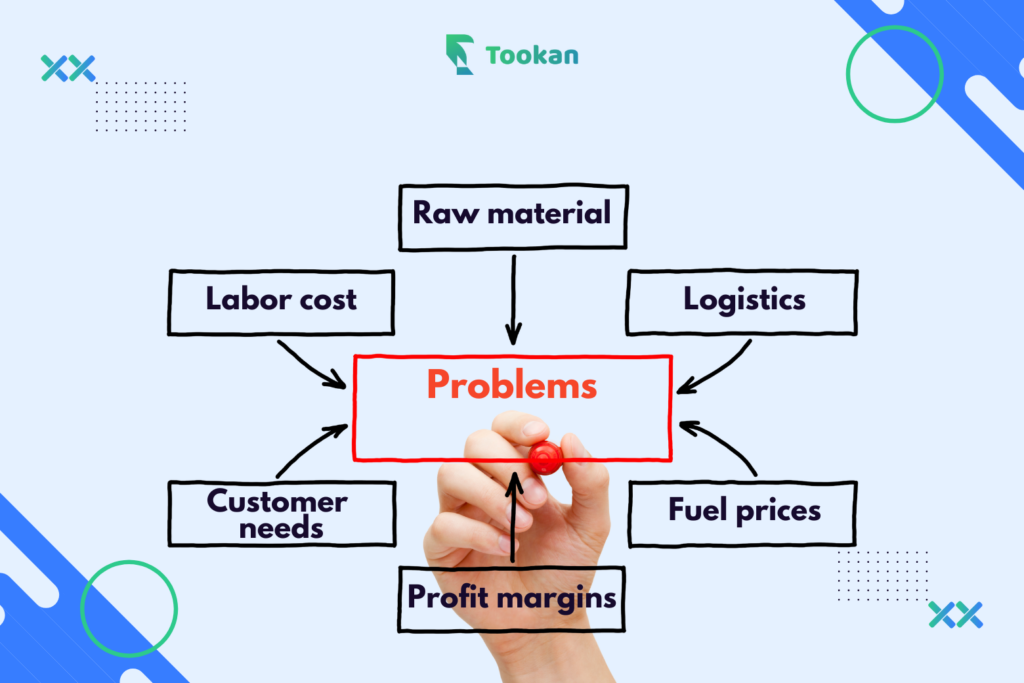
- Products
- Solutions
- Learn
- Partner
- Try Now
The reality of inflation stares at us everywhere these days from gas stations to grocery stores to reading the latest news articles. Many reports are indicating that inflation is at a 40% high. It is expected that we can expect a further 15% rise by the end of the year. Grocery bills for people are going up by a steady 8 to 10% every year during and after the pandemic.

Problems for food retailers due to inflation
These days food manufacturers have to face several problems such as rising labor costs, rising raw material prices, and shipping delays. This has resulted in surging inflation across the world and has led to several manufacturers and suppliers passing on this burden over to the food retailers. They are in turn forced to pass on a part of these growing prices over to the consumers.
In 2021 the prices of seafood, cereal, meat, produce, and other kitchen staples rose by 9%. Food retailers are looking for some middle ground that will protect their bottom line. The challenge is to do so, without burdening the shoppers with these skyrocketing prices. Using technology can be the answer to this problem.

Strategies being used by food retailers to tackle inflation
Bloomberg anticipates that most food delivery services will struggle to outrun inflation, as consumers are likely to pull back on discretionary purchases. As a result, the CFOs of food companies are using different strategies to try and curb the impact of inflation. Let’s take a look at some of them.

1. Inflation forecasting and planning
Many organizations are using inflation forecasts for getting a better understanding of how different costs will develop in the upcoming months. This allows companies to prepare for eventualities and take corrective measures if needed to offset the rising food prices.
Some companies are expecting higher inflation rates during the remainder of the year and at the beginning of the next year. As a result, they are increasing their prices. You can observe a rise in prices across a product portfolio. At the same time, they are also looking out for better productivity.
2. Raising the prices
Some companies such as General Mills for example also took this approach of raising the prices for some of their products in recent months. However, the executives have to ensure that these rises in pricing are in line with what their competitors are doing. Otherwise, these companies will risk losing out on customers. In addition, companies have to determine if the new pricing will cover the anticipated food price rise in the upcoming quarters.
3. Streamlining
All the CFOs working in the food industry are trying to make their operations more efficient. The focus is to either cut down the prices or reallocate some spending, or perform some other actions in combination with these steps. The conventional way of battling inflation is through strict control over expenses. This fact has been reiterated by several experts who work in the industry.
4. Raising the sales push
Different food businesses are raising their efforts for boosting their revenues and shielding their bottom lines better. Higher revenues can offset some of these costs because they normally do not rise as much as the sales of an organization. For instance, the famous restaurant chain Red Robin took into consideration newer sales initiatives together with some cost-cutting measures, and more price rises as the inflation persisted. Other efforts to consider are developing loyalty programs and extending partnerships with other suitable businesses.
5. Strategic buying
Some organizations are trying to restrict their exposure to inflation by making some strategic buying of raw materials and goods when the prices are on the lower side. One of the examples of this is McCormick. This company is always on the lookout to buy things when the pricing is right. This strategy helped the company in securing its supplies at moderate product costs according to its CFO.
Using technology to mitigate inflation
There are some technological solutions available for combating inflation such as intelligent data collection, waste-reducing tools, and money-saving apps. These tools provide the retailers with all the info required for offering discounts and promotions on different popular items while allowing the consumers to compare the pricing and save money.

Several food retailers have already begun to adopt advanced analytics systematically and to a great effect. The margins involved in grocery retail usually range between one to two percent. Food retailers are aware that the use of data analytics is the key to maximizing this profit margin. For instance, some retailers invest in smart cameras that assess and observe customer movements in a store. All these insights allow food retailers to develop a sustainable sales system with some useful applications for several scenarios such as winter or holiday season rush, summer shopping, etc.
1. Intelligent data collection
The use of data collection technology allows food retailers to understand what is taking place on their floors. It helps identify and predict the changes in shopper behavior and preferences. When a retailer is armed with these insights, they can optimize their inventories, avoid excessive ordering, and address potential supply shortages. It is especially significant while dealing with perishable items. Each year close to 1.3 billion tons of food gets wasted around the world. The food retailers can effectively decrease this number with better inventory management and a reduction in overstock.
2. Waste reducing technology
Worldwide around a third of all food gets wasted. This is a staggering rate with a whopping $1 trillion price tag. It burdens both consumers and retailers who are working on thin margins and are facing losses on all items that will not sell. To mitigate this problem the food retailers can use integrated apps and other digital marketing channels for offering the customers different products that would have otherwise been trashed out at discounted rates. Customers are also happy because they are saving money on good food. Retailers are happy because they can recoup some of their money on inventories rather than scrapping all their stock.
3. Using apps
The meal planning apps are extremely useful to the consumers to accurately get, the amount and type of food they require. It eliminates the expenditure on products that are not required and acts as a demarketing strategy for brands looking to retain consumers despite the rising inflation. Even the food retailers can themselves host digital platforms for selling their products. They can use the meal planning technology and offer recipes depending on the deals they are offering. They may also offer seasonal bulk products to the consumers.
4. Offering customer loyalty programs
As data has the power to decide how frequently a customer will buy a specific product and at what point he will do so, this may be utilized effectively for customer loyalty programs. You can offer the returning customers different discounts on some of your recurring items. This effect can be multiplied if done at the time when customers are looking to make a repeat purchase. The more data these grocers can analyze the better they are going to get at optimizing the marketing budgets. They will be in a great position to offer more effective and targeted promotions.
To sum it up
The money-saving technologies used for shopping for food items such as those described above are user-friendly as well. These technologies are in ready condition to get widespread adoption across the world. Food retailers that embrace these tools are going to achieve savings not only for themselves but also for consumers that are looking to shop economically. They will also enjoy the fruits of having customer loyalty and raised revenues.
If you are looking for any technology-based solution for your retail operations, look no further than Jungleworks for professional assistance. We provide innovative technology to enable the entire food journey of the retailer. Moreover, we have helped clients across Europe, North America, and Asia and have worked with top brands in the area.
Subscribe to stay ahead with the latest updates and entrepreneurial insights!

Subscribe to our newsletter
Get access to the latest industry & product insights.





















